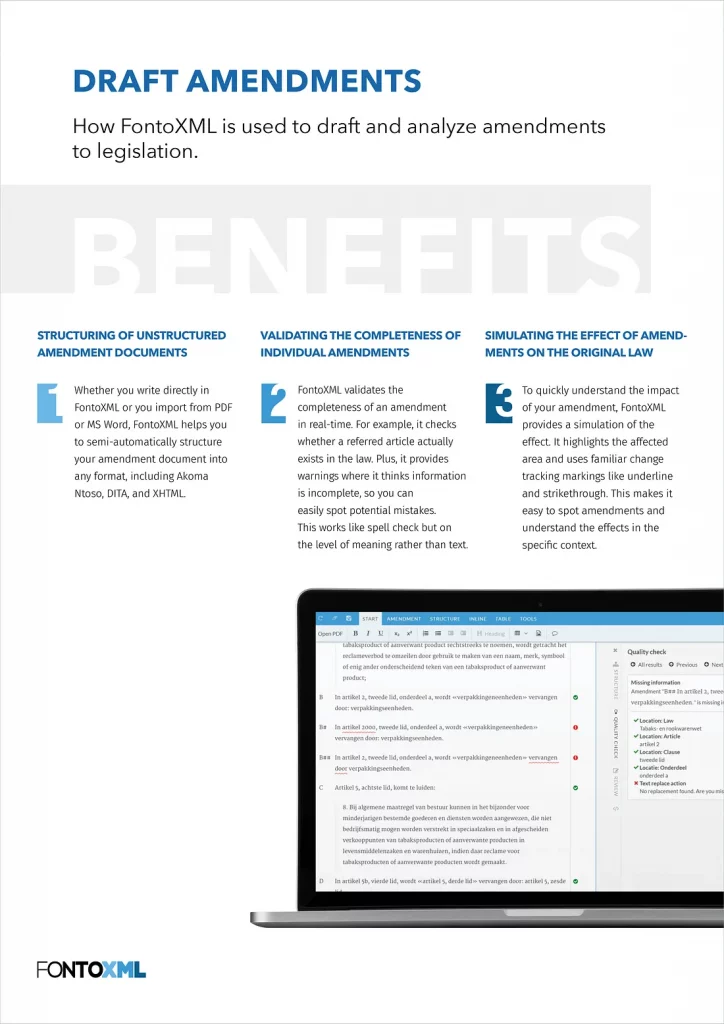Several of our customers are governments or publishers working with legislative content. One of the most important documents published by them are the amendment documents. In this blog post I’ll show you how FontoXML helps authoring these amendment documents.
For those new to legislative processes and corresponding documents: new legislation is often introduced by augmenting an existing law rather than introducing an entirely new law. This process is called “amending” the law. An amendment is a formal or official change made to a law, contract, constitution, or other legal document. It is based on the verb to amend, which means to change for better. Amendments can add, remove, or update parts of these documents.
Let’s look at an example:
In paragraph A57C(b)(vi), for “his”, substitute “their”.
This amendment makes a change to paragraph A57C, clause b, number 6 in the British Immigration Rules (not shown in example). The change is to replace the word “his” by the word “their”.
These amendments are written by elected deputies in collaboration with the drafting office. The deputy starts the drafting process by writing down his or her ideas on what the law should look like. This first draft is sent to the drafting office where it is the drafter’s job to make sure the amendment preserves the integrity and coherence of the entire legal system. This usually requires making more changes to the amendment. Once they’re both happy with the amendment proposal, it is presented in chamber and voted upon resulting in a ratified law (I’m simplifying and skipping steps here).
During several of these steps the amendment proposal is converted to other formats, including Word and printed pages. You can already see why an XML-first workflow would save both time and effort.
At FontoXML, we feel that an XML-first workflow should benefit all users, not just save cost for ‘the organisation’. This is why we started an internal experiment to see what FontoXML can do for (amendment) authors. We set out to reach the following benefits, specifically for the deputy and the drafter:
- Structuring of unstructured amendment documents;
- Validating the completeness of individual amendments;
- Simulating the effect of amendments on the original law.
I’ll describe how we achieved these benefits.
1. Structuring of unstructured amendment documents
In a perfect world, there is no need for a tool which helps to structure an unstructured document since authors would be writing it in a structured content editor like FontoXML. However, the world is clearly not perfect: a deputy may write an amendment on a piece of paper or copy text from a European law proposal. Whatever happens, it should be easy to transform that unstructured content into a properly structured document.
For this experiment, we implemented a PDF-to-XML conversion which strips out typical page information like the page header and footer. This yields a document which basically contains just the text of the uploaded PDF. This is similar to the result of copy & pasting content from a plain text document.
The next step is to structure the document. In the case of an amendment document it is tagging articles, paragraphs, clauses, etc. Users can do this manually in FontoXML using the corresponding toolbar buttons. However, to save them time, we employed FontoXML Content Quality to automatically scan the content and provide suggestions for structure.
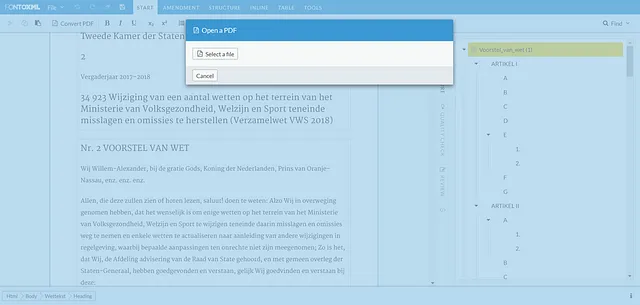
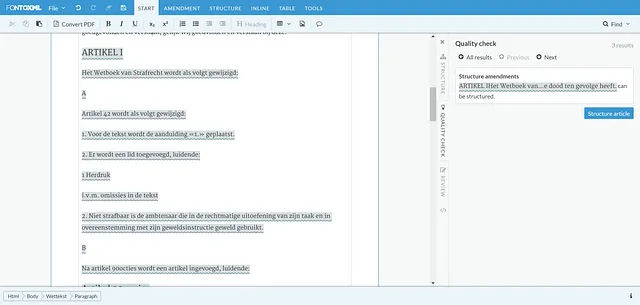
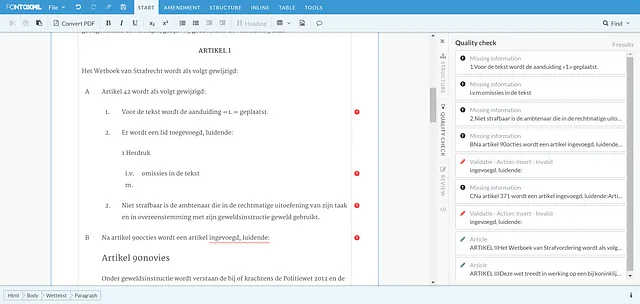
The end result of this step is a well-structured document which can be automatically published with very little effort.
2. Validating the completeness of individual amendments
Although the final judgement of whether an amendment is considered valid and correct must be left to humans at all times, FontoXML assists in real-time where it can. For example, if a user writes an amendment to change article X in law Y, FontoXML tests whether article X actually exists in law Y and warns the user if it doesn’t. FontoXML also determines whether the basic components (location and action) which make up an amendment are actually present and give a warning otherwise.
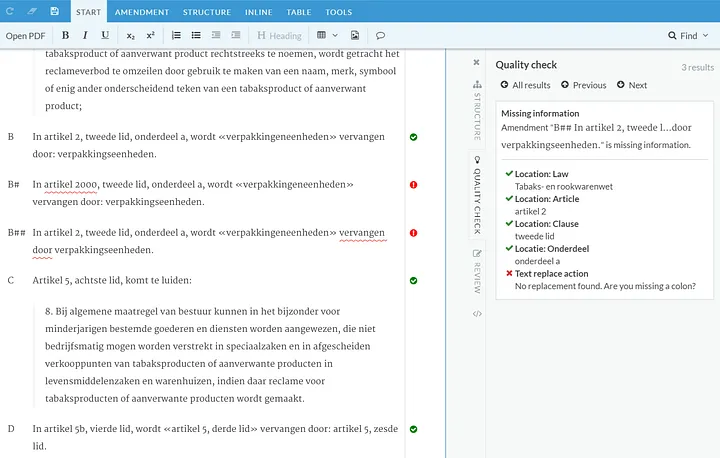
On the left-hand side of the screenshot, there is the actual amendment document. The amendment in clause B is valid as indicated by the green check mark next to it. Clause B# is invalid because article 2000 does not exist in the target law. This is signaled by the red squiggle underline. Clause B## is invalid because it is missing a colon after the words “vervangen door” (substitute with). On the right-hand side you’ll see the details of the warning for clause B##.
While validating the amendments, FontoXML is also scanning the text for potential spelling & grammar mistakes and the use of the proper controlled language. This helps writing more consistent amendments resulting in more consistent language across the entire legal system.
3. Simulating the effect of amendments on the original law
The goal of the simulation is to simulate the effect of the change described in an amendment to the original law text. Via this simulation, the user gets a real-time preview of the result of an amendment. This enables them to see whether the intended effect is actually achieved.
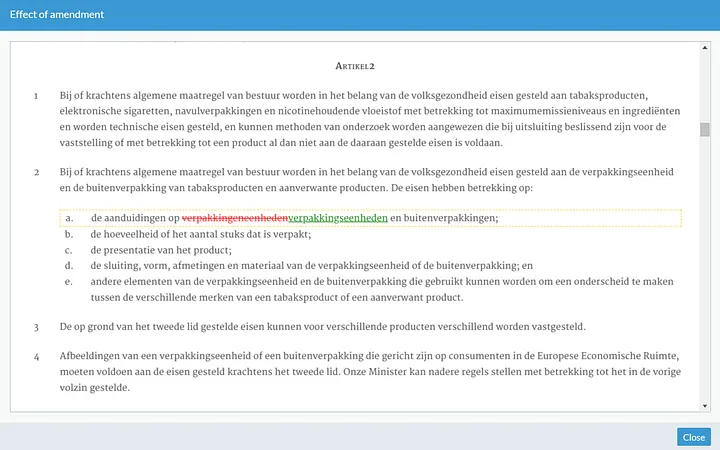
As seen in the screenshot, the UI highlights the changes using familiar change representation: text in red and strike-through is deleted and green underlined text is added. The yellow dotted border indicates the area affected by the simulated amendment. This gives the user a clear picture on what the original law will look like once the amendment is ratified.
Conclusion
Adopting an XML-first workflow for legislative documents, including amendments, does not only streamline your end-of-pipe publishing process by enabling automated conversions. With some thought, you can also make your users happier and more productive by giving them an authoring environment which actually aids them.
Want to learn more? Feel free to contact us for a in-depth demo or just a good conversation.
